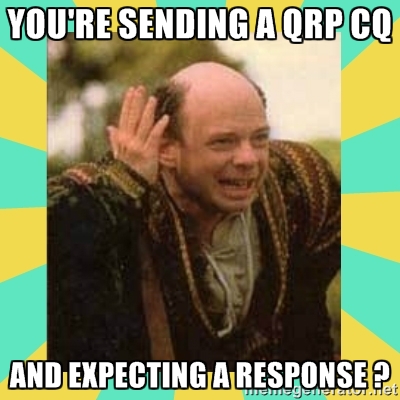Posts Tagged ‘80m’
 Can anybody hear me
Can anybody hear me
Calling QRP CQ - Inconceivable
Amazingly my 80m Windom / OCF Dipole has 4.5:1 SWR native around 1.8 mHz and it matches easily with a tuner across the entire 160m band. That was a surprise.
I tossed my mighty 5 watts call out at 1810 kHz not expecting much...
So how do you know if and where your signal is getting out ?
The Reverse Beacon Network
| Map of the last 100 reports from Reverse Beacon stations of my call sign Color coded by band |
It even includes a speedometer
| My brief speed key session with N4HAY |
Summary
 160m/80m DC transceiver
160m/80m DC transceiver
These are bands I rarely use, but some readers may be interested in the Hendricks Kits dual band transceiver. 5.5W sounds enough to work plenty.
These days, the main issue on these bands can be man-made noise from TVs, SMPUs and similar. At my old QTH I had an S7-8 noise floor on 160m and 80m. At the new QTH the noise floor on these bands is low currently, but this could change overnight. Some people use loops and nullers on RX to minimise problems. If you have a quiet noise environment then this transceiver may fit your needs. Don’t forget you will need a reasonably big antenna to get decent results. A half wave 160m dipole antenna is around 240 feet long.
In my youth we had rigs like the Codar AT5 12W AM/CW 160m/80m transmitter and companion T28 RX. I had the RX but not the TX although I did use an AT5 from the QTH of the late G4PJ. The T28 was mainly used as a tunable IF for my 2m converter. I heard my first 2m satellite signals via Oscar 6 and 7 using the T28 as a tunable IF. I remember being very thrilled hearing my first transatlantic stations on the top end of 2m.
 New band tried with "compromise" antenna.
New band tried with "compromise" antenna.
This afternoon I tried 80m WSPR with the “compromise” antenna (V2000 + 2m halo with strapped feeders) with some success. On 80m I copied M0BLP and PA0WMR although there were very few stations active. I was not copied by anyone. I was going to try 160m but decided there was too little activity.
Later I used 40m and 20m with the Par end-fed. On 40m, just one transmission resulted in 10 spots in 7 countries. The next transmission resulted in not a single report, probably because I was sitting on the frequency of a very strong station who was TXing at the time?
I later returned to 10m, and spotted EA5CYA (1376km) and LZ1OI (2145km) by Es around teatime. The Spanish station was pretty strong but the LZ was much weaker.













